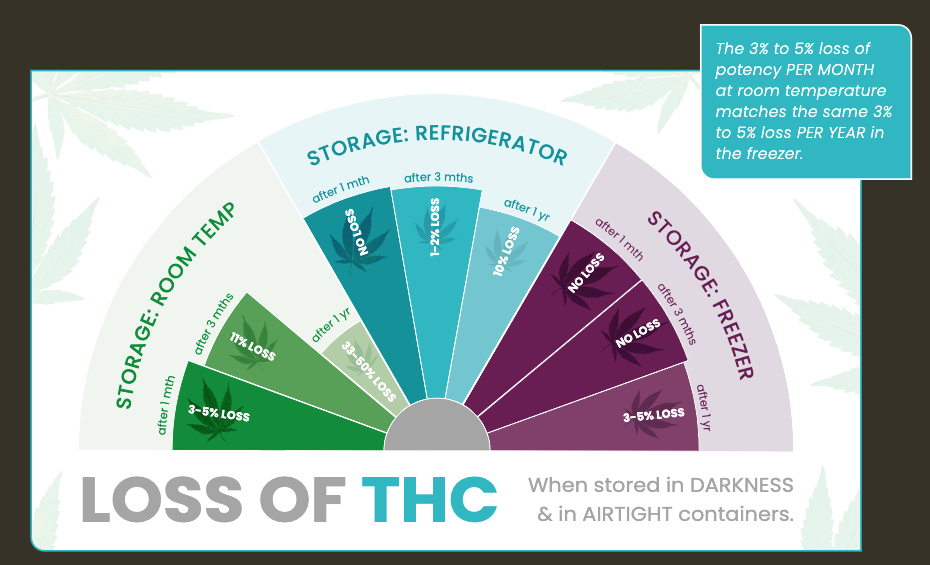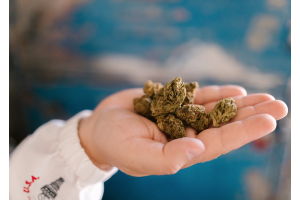How to Preserve the Potency Of Pot

Warmth. Light. Air. Water. The same elements that empower living plants to grow and flourish also reduce the potency of cannabis after it’s been dried and cured.
This is especially true for stash stored in permeable containers or exposed to light or to hot and humid air. By a lucky coincidence, the word Pot is woven into the word Potency, so it’s high time to learn the applied science and fine art of preserving the Potency of your Pot.
Herbology 101
The stronger the smoke, the less you will toke. That’s simple arithmetic. Compared to strains of lower potency, a higher power flower can medicate you or elevate you with less huffing and puffing. And the less you toke, the less you endanger the health of your lungs. That too is simple arithmetic. Bedazzled by enticing numbers, some cannabis connoisseurs chase after THC as their top-choice cannabinoid. Judging cannabis by its ratio of THC alone is as simplistic as rating wine solely by its percentage of alcohol. THC content is more a measure of quantity than of quality. Over 1251 other cannabinoids in cannabis contribute to your high or to your relief. The same headcount applies to terpenes, the aromatic oils that distinguish a strain of cannabis by its colors, flavors, and aromas. Over 100 different terpenes can make the air redolent with the sweet and skunky fragrance of Eau de Cannabis. The entire profile of all the cannabinoids and terpenes contributes to your euphoria or analgesia. Their synergy is dubbed the “entourage effect.”2 Unlike concentrates and derivatives that are isolated and extracted from nature, raw and wholesome cannabis equals more than the sum of its parts. That’s why, despite the proliferation of alternative methods of consumption, the smoking and vaping of whole herb remain so popular. To preserve that full entourage, whole herbal cannabis requires proper storage.
The Proof is in the Puffing
All dried herbal veggies and especially those with pungent aromas lose their potency over time. For this reason, culinary chefs recommend consuming dried seasonings within two years, and of aromatic herbs within one year. As an aromatic herb, cannabis is ruled by the same inescapable laws of physics as are basil and oregano. When you purchase cannabis from a legal source, the label on the container may list the percentage of some of its terpenes, its CBD (technically CBD combined with CBDa), and its THC (again, actually THC combined with THCa). If the label boasts an astounding 38% THC, that may have been accurate upon analysis, but not for when you purchase or consume that batch. If proof is in the puffing, you may later have good cause to question that eyepopping number.In nutritional supplements, potencies printed on labels take into account that their strengths diminish over time. In order to remain accurate until their expiration dates, the potencies during manufacture exceed what’s stated on their labels.3 You get more than what you paid for. The analyses listed for dried and cured cannabis, however, grant no such grace period. Due to time lag, the inflated numbers you read on the label or website are not what you get. You get less than what you paid for. From the moment the cannabis was analyzed, its strength declines when exposed to the elements of Warmth, Light, Air, and Moisture.
WARMTH – Keep It Cool, Baby
No matter how airtight or waterproof or childproof the container, it is not heatproof. Temperature grossly affects the rate at which cannabinoids and terpenes inevitably decompose. Researchers have conducted many controlled experiments chronicling the depletion of THC over time. Let’s examine the results of just three of them. As the first of its kind, an American study4 showed that dried cannabis stored in darkness and in airtight containers, but at room temperature, lost THC content at the rate of 3% to 5% per month, which after one year compounded to a loss of between one-third and one-half.5In 2015, an Austrian study6 analyzed dried cannabis stored in darkness, in airtight containers, and at room temperature. Their results were “in good accordance”7 with the American study that indicated THC loss of 3% to 5% per month.
The Austrian researchers also froze samples at -25ºC (-13ºF). After four months, the THC content remained totally stable. After one year, slight loss was barely detectable.8In 2019, an Italian study9 sealed samples in airtight containers under four different environments. The variables were light and temperature. Exhibits A and B both were stored at room temperature, A exposed to light, and B shielded in darkness. Exhibits C and D both were held in darkness, C refrigerated at 4ºC (39ºF), and D frozen at -20ºC (-4ºF). After three months, the THC in Exhibit A had degraded 13%, and in Exhibit B 11%. Only slight loss was noted in refrigerated C. Frozen D showed no loss at all.10Three months is an average turnaround time between when legal cannabis is analyzed and then imbibed. As shops store their cannabis at room temperatures, no wonder their claims of high potencies so often prove unfounded.
After one year, Exhibit A exposed to light lost slightly more than 50% of its THC content, and B in darkness slightly less than 50%. Refrigerated Exhibit C lost 10%, while frozen D lost less than 5%.11One year is the typical turnaround time for outdoor growers who harvest their crops in the fall and stretch their personal supplies into summer. If you grow your own and intend your outdoor harvest to last a year, you should freeze it. The Italian researchers’ important takeaway is that, “Freezing is the best storage condition to avoid the reduction of the cannabinoids content over time.”12 Truly frozen in time.Be aware that frozen herb demands special handling.
When frozen, the delicate resin-rich trichomes can turn brittle.13 If shaken, the trichomes can flake off. So pack your cannabis to the brim so that it does not rattle inside its container. Also, avoid thawing frozen herb and then refreezing it. That second cycle can cause your bud to crumble to pieces. This happens to baked foods such as bread and cookies that are refrozen and rethawed. That’s the way the cookie crumbles.Storage Tip for Temperature Control: For short-term storage, place cannabis in the fridge. For storage longer than three months, freeze it. Because refrigerators and freezers are humid inside, first seal your cannabis in airtight and therefore watertight containers. Keep only your room at room temperature, not your stash.
LIGHT – It’s Better to Sit in the Dark
Light is the power source for all living plants that harness that energy with their chlorophyll. Cannabis grows in the
All dried herbal veggies and especially those with pungent aromas lose their potency over time. For this reason, culinary chefs recommend consuming dried seasonings within two years, and of aromatic herbs within one year. As an aromatic herb, cannabis is ruled by the same inescapable laws of physics as are basil and oregano. When you purchase cannabis from a legal source, the label on the container may list the percentage of some of its terpenes, its CBD (technically CBD combined with CBDa), and its THC (again, actually THC combined with THCa).
If the label boasts an astounding 38% THC, that may have been accurate upon analysis, but not for when you purchase or consume that batch. If proof is in the puffing, you may later have good cause to question that eyepopping number.In nutritional supplements, potencies printed on labels take into account that their strengths diminish over time. In order to remain accurate until their expiration dates, the potencies during manufacture exceed what’s stated on their labels.3 You get more than what you paid for. The analyses listed for dried and cured cannabis, however, grant no such grace period. Due to time lag, the inflated numbers you read on the label or website are not what you get. You get less than what you paid for. From the moment the cannabis was analyzed, its strength declines when exposed to the elements of light, but once cannabis is harvested that light betrays it and becomes its destroyer. Light and especially sunlight fade colors, shred plastic, sunburn skin, and degrade the potency of any dried herb. That 2019 Italian study and every previous study it had cited all showed that light degrades the THC.14Storage Tip for Light Control: Aspire to see the light, but do not store dried cannabis in it. To preserve cannabis, seek the darkness.

AIR & MOISTURE – Gone with the Wind
Oxygen is air’s main culprit responsible for decomposition, aptly called oxidation. Oxygen rusts metals, fans flames, spoils foods, ages living matter, and reduces the potency of any dried herb. Match the size of your container to your stash because when a container locks air and moisture out, it also locks them in. Even worse, if odor is leaking out, then air is seeping in.Seek an airtight hard container whose static charge is nearly neutral, else trichomes adhere to its walls. The frontrunners are glass jars followed by metal cannisters that, unlike glass, block out light.
But both are only as secure as their lids. Durable bags that are almost as airtight while not too staticky include oven bags, silicone food storage bags, and mylar pouches and bags. Mylar is such a compact choice that some pot shops package cannabis in mylar pouches. Containers that are airtight are also watertight, so when your container is impermeable to air you are freeing two birds from one cage.The Sniff Test Put to the Sniff Test Among the vast annals of cannabis research, the most wildly imaginative experiment was published in 2020.15Researchers investigated the cue for warrantless searches during traffic stops when American police officers claim to detect the distinct aroma of unsmoked bud. Real-world
traffic stops mingle with a vehicle’s competing Smell-a-Rama of tobacco smoke, body sweat, smelly socks, air fresheners, luxury perfumes, leftover food, gasoline fumes, and tailpipe exhaust. Amid such odiferous distractions, can a cop’s claim be credible that drivers’ cars did not pass the cop’s sniff test? To find out, researchers put the sniff test to the sniff test.Two fresh strains of dried bud were each dispensed into five different plastic containers.
Each container then was paired with an identical container that was left empty to serve as a plasticized placebo. The five different containers included: an open bowl; second, a food storage bag made of HDPE (plastic recycle number 2); third, a resealable food storage bag made of LDPE (recycle number 4), the kind in which black market cannabis is traditionally peddled; fourth, a pharmacy vial made of polypropylene (number 5), the type in which many dispensaries market medical marijuana; and fifth, vacuum-sealed double sheets of composite polyethylene and nylon.16 (Glass jars, metal cannisters, oven bags, and silicone and mylar food storage bags were notably omitted because those were seldom used for transporting contraband cannabis.)The containers were randomly placed one at a time into separate chambers simulating the interior of a car and were sniffed by 21 seasoned cannabis users who had developed a good nose for cannabis.
In case they could see past their nose and had developed a good eye for the herb, they were blindfolded. The cannabis was detected with “100% accuracy”17from the open bowl (no surprise there!) and from the LDPE and HDPE food bags. Cannabis in the pharmacy vial was detected most of the time. Only the doubly vacuum-sealed composite sheets “reduced diffusion of cannabis odor to levels where olfactory detection”18 was totally eliminated. The odious other containers all failed to contain their odors. If odor was leaking out, then air was seeping in.Storage Tip for Air Defense: The classics among static-free airtight hard containers are glass jars and metal cannisters. Mylar or silicone food bags and oven bags are almost as airtight, but not as free of static
The Daily GrindWhen it’s time to test if your preservation efforts rendered their desired effects, sit back and toke up. In order to keep it fresh, you’ve also kept your bud whole. Until now.Whether its destination is a joint or a hand pipe or a waterpipe or an herbal vaporizer, the cannabis should be ground in order to assure consistent and thorough combustion. In a pinch, you can crush a bud between your fingers, though you’ll lose the oily trichomes deposited on your fingertips where you won’t be able to smoke it. Disk-like pocketsize herbal grinders to the rescue. The resinous oils will coat a grinder’s interior once, and hardly further. As grinding exposes the herb’s highly perishable oils to air and therefore oxidation, grind only just before use.
Futility and Ephemerality
No matter what precautions you might take to curb erosion by the windswept sands of time, cannabis will lose some potency with age. The fragility of cannabis teaches us lessons in the futility of hoarding and in the ephemerality of all existence.Storage Tip to Preserve Potency: Loss of potency over time makes it imperative to store cannabis properly. Recite this incantation: “If odor is leaking out, then air is seeping in.” Protect cannabis in airtight containers and in darkness. The 3% to 5% loss of potency per month at room temperature matches the same 3% to 5% loss per year in the freezer. For easy access, retain only a small portion at room temperature. Chill the rest of your vulnerable stash in the fridge or freezer. Having observed these precautions, you now can chill out.
Written and Published by Mark Mathew Braunstein in Weed World Magazine issue 162
Featured Image: Pexels












Validate your login